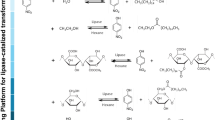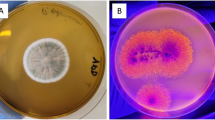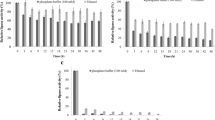Abstract
Fungal enzymes are widely used in technological processes and have some interesting features to be applied in a variety of biosynthetic courses. Here, free and substrate-immobilised lipases from Fusarium verticillioides P24 were obtained by solid-state fermentation using wheat bran as substrate and fungal carrier. Based on their hydrolytic and transesterification activities, the lipases were characterised as pH-dependent in both reactions, with higher substrate conversion in an alkaline environment. Thermally, the lipases performed well from 30 to 45 °C, being more stable in mild conditions. Organic solvents significantly influenced the lipase selectivity using different vegetable oils as fatty acid source. Omega(ω)-3 production in n-hexane achieved 45% using canola oil, against ≈ 18% in cyclohexane. However, ω-6 production was preferably produced for both solvents using linseed oil with significant alterations in the yield (≈ 79% and 49% for n-hexane and cyclohexane, respectively). Moreover, the greatest enzyme selectivity for ω-6 led us to suppose a lipase preference for the Sn1 position of the triacylglycerol. Lastly, a transesterification reaction was performed, achieving 90% of ester conversion in 72 h. This study reports the characterisation and use of free and substrate-immobilised lipases from Fusarium verticillioides P24 as an economic and efficient method for the first time.





Similar content being viewed by others
References
Hesham, A., & E. E. (2007). Filamentous fungal cultures-process characteristics, products, and applications. In Bioprocessing for Value-Added Products from Renewable Resources. Elsevier B.V. https://doi.org/10.1016/B978-0-444-52114-9.50010-4.
Pérez, D., Martín, S., Fernández-Lorente, G., Filice, M., Guisán, J. M., Ventosa, A., et al. (2011). A novel halophilic lipase, LipBL, showing high efficiency in the production of eicosapentaenoic acid (EPA). PloS one, 6(8), e23325. https://doi.org/10.1371/journal.pone.0023325.
Hung, T.-C., Giridhar, R., Chiou, S.-H., & Wu, W.-T. (2003). Binary immobilization of Candida rugosa lipase on chitosan. Journal of Molecular Catalysis B: Enzymatic, 26(1–2), 69–78. https://doi.org/10.1016/S1381-1177(03)00167-X.
da Silva, C. C. F., Contesini, F. J., & Carvalho, P. d. O. (2009). Enantioselective behavior of lipases from Aspergillus niger immobilized in different supports. Journal of Industrial Microbiology and Biotechnology, 36(7), 949–954. https://doi.org/10.1007/s10295-009-0573-4.
Krishna, S. H., Prapulla, S. G., & Karanth, N. G. (2000). Enzymatic synthesis of isoamyl butyrate using immobilized Rhizomucor miehei lipase in non-aqueous media. Journal of Industrial Microbiology and Biotechnology, 25(3), 147–154.
Lima, L. N., Oliveira, G. C., Rojas, M. J., Castro, H. F., & Tardioli, P. W. (2015). Immobilization of Pseudomonas fluorescens lipase on hydrophobic supports and application in biodiesel synthesis by transesterification of vegetable oils in solvent-free systems. Journal of industrial microbiology & biotechnology, 42(4), 523–535. https://doi.org/10.1007/s10295-015-1586-9.
Fernandez-Lafuente, R., Armisén, P., Sabuquillo, P., Fernández-Lorente, G., & Guisán, J. M. (1998). Immobilization of lipases by selective adsorption on hydrophobic supports. Chemistry and physics of lipids, 93(1–2), 185–97. Retrieved from http://www.ncbi.nlm.nih.gov/pubmed/9720258
Ben Akacha, N., & Gargouri, M. (2015). Microbial and enzymatic technologies used for the production of natural aroma compounds: Synthesis, recovery modeling, and bioprocesses. Food and Bioproducts Processing, 94(May 2014), 675–706. https://doi.org/10.1016/j.fbp.2014.09.011.
Lokha, Y., Arana-Peña, S., Rios, N. S., Mendez-Sanchez, C., Gonçalves, L. R. B., Lopez-Gallego, F., & Fernandez-Lafuente, R. (2020). Modulating the properties of the lipase from Thermomyces lanuginosus immobilized on octyl agarose beads by altering the immobilization conditions. Enzyme and Microbial Technology, 133, 109461. https://doi.org/10.1016/j.enzmictec.2019.109461.
de Oliveira, B. H., Coradi, G. V., de Oliva-Neto, P., & do Nascimento, V. M. G. (2020). Biocatalytic benefits of immobilized Fusarium sp. (GFC) lipase from solid state fermentation on free lipase from submerged fermentation. Industrial Crops and Products, 147(February), 112235. https://doi.org/10.1016/j.indcrop.2020.112235.
de Oliveira Rodrigues, P., Gurgel, L. V. A., Pasquini, D., Badotti, F., Góes-Neto, A., & Baffi, M. A. (2020). Lignocellulose-degrading enzymes production by solid-state fermentation through fungal consortium among Ascomycetes and Basidiomycetes. Renewable Energy, 145, 2683–2693. https://doi.org/10.1016/j.renene.2019.08.041.
Singh, R. S., Chauhan, K., Kaur, K., & Pandey, A. (2020). Statistical optimization of solid-state fermentation for the production of fungal inulinase from apple pomace. Bioresource Technology Reports, 9(November 2019), 100364. https://doi.org/10.1016/j.biteb.2019.100364.
Wang, L., & Yang, S. T. (2007). Solid state fermentation and its applications. In Bioprocessing for Value-Added Products from Renewable Resources. Elsevier B.V. https://doi.org/10.1016/B978-044452114-9/50019-0.
Muller Dos Santos, M., Souza Da Rosa, A., Dal’Boit, S., Mitchell, D. A., & Krieger, N. (2004). Thermal denaturation: is solid-state fermentation really a good technology for the production of enzymes? Bioresource Technology, 93(3), 261–268. https://doi.org/10.1016/j.biortech.2003.11.007.
Fernandes, M. L. M., Saad, E. B., Meira, J. A., Ramos, L. P., Mitchell, D. A., & Krieger, N. (2007). Esterification and transesterification reactions catalysed by addition of fermented solids to organic reaction media. Journal of Molecular Catalysis B: Enzymatic, 44(1), 8–13. https://doi.org/10.1016/j.molcatb.2006.08.004.
Shinkawa, S., & Mitsuzawa, S. (2020). Feasibility study of on-site solid-state enzyme production by Aspergillus oryzae. Biotechnology for Biofuels, 3(1), 1–15. https://doi.org/10.1186/s13068-020-1669-3.
Perez, C. L., Casciatori, F. P., & Thoméo, J. C. (2019). Strategies for scaling-up packed-bed bioreactors for solid-state fermentation: the case of cellulolytic enzymes production by a thermophilic fungus. Chemical Engineering Journal, 361(December 2018), 1142–1151. https://doi.org/10.1016/j.cej.2018.12.169.
Rodrigues, I. d. S. V., Barreto, J. T., Moutinho, B. L., Oliveira, M. M. G., da Silva, R. S., Fernandes, M. F., & Fernandes, R. P. M. (2020). Production of xylanases by Bacillus sp. TC-DT13 in solid state fermentation using bran wheat. Preparative Biochemistry and Biotechnology, 50(1), 91–97. https://doi.org/10.1080/10826068.2019.1663536.
Brotas, M. S. C., Carvalho, G. A., & Pereira, P. A. P. (2020). Determination, through derivatization and GC-MS analysis, of omega-3 and omega-6 fatty acids in fish oil capsules sold in Salvador, Bahia. Journal of Brazilian Chemical Society, 31(3), 447–455.
Adarme-vega, T. C., Lim, D. K. Y., Timmins, M., Vernen, F., Li, Y., & Schenk, P. M. (2012). Microalgal biofactories: a promising approach towards sustainable omega-3 fatty acid production. Microbial Cell Factories, 11(96), 1–10.
Simopoulos, A. P. (2016). An increase in the omega-6/omega-3 fatty acid ratio increases the risk for obesity. Nutrients, 8(3), 1–17. https://doi.org/10.3390/nu8030128.
Moreno-Perez, S., Turati, D. F. M., Borges, J. P., Luna, P., Señorans, F. J., Guisan, J. M., & Fernandez-Lorente, G. (2017). Critical role of different immobilized biocatalysts of a given lipase in the selective ethanolysis of sardine oil. Journal of Agricultural and Food Chemistry, 65(1), 117–122. https://doi.org/10.1021/acs.jafc.6b05243.
Moreno-Pérez, S., Guisan, J. M., & Fernandez-Lorente, G. (2014). Selective ethanolysis of fish oil catalyzed by immobilized lipases. JAOCS, Journal of the American Oil Chemists’ Society, 91(1), 63–69. https://doi.org/10.1007/s11746-013-2348-3.
Moazeni, F., Chen, Y. C., & Zhang, G. (2019). Enzymatic transesterification for biodiesel production from used cooking oil, a review. Journal of Cleaner Production, 216, 117–128. https://doi.org/10.1016/j.jclepro.2019.01.181.
Hama, S., Tamalampudi, S., Fukumizu, T., Miura, K., Yamaji, H., Kondo, A., & Fukuda, H. (2006). Lipase localization in Rhizopus oryzae cells immobilized within biomass support particles for use as whole-cell biocatalysts in biodiesel-fuel production. Journal of bioscience and bioengineering, 101(4), 328–333. https://doi.org/10.1263/jbb.101.328.
Bradford, M. M. (1976). A rapid and sensitive method for the quantitation of microgram quantities of protein utilizing the principle of protein-dye binding. Analytical Biochemistry, 72(1–2), 248–254. https://doi.org/10.1016/0003-2697(76)90527-3.
Winkler, U. K., & Stuckmann, M. (1979). Glycogen, hyaluronate, and some other polysaccharides greatly enhance the formation of exolipase by Serratia marcescens. Journal of Bacteriology, 138(3), 663–670. https://doi.org/10.1128/jb.138.3.663-670.1979.
Fuciños, P., Abadín, C. M., Sanromán, A., Longo, M. A., Pastrana, L., & Rúa, M. L. (2005). Identification of extracellular lipases/esterases produced by Thermus thermophilus HB27: partial purification and preliminary biochemical characterisation. Journal of Biotechnology, 117(3), 233–241. https://doi.org/10.1016/j.jbiotec.2005.01.019.
Soares, C. M. F., De Castro, H. F., De Moraes, F. F., & Zanin, G. M. (1999). Characterization and utilization of Candida rugosa lipase immobilized on controlled pore silica. Applied Biochemistry and Biotechnology - Part A Enzyme Engineering and Biotechnology, 77–79, 745–757. https://doi.org/10.1385/abab:79:1-3:745, 1-3
Urioste, D., Castro, M., Biaggio, F., & Castro, H. (2008). Síntese de padroes cromatográficos e estabelecimento de método para dosagem da composiçao de ésteres de ácidos graxos presentes no biodiesel a partir do óleo de babaçu. Química Nova, 31(2), 407–412.
Ichihara, K., & Fukubayashi, Y. (2010). Preparation of fatty acid methyl esters for gas-liquid chromatography. Journal of Lipid Research, 51(3), 635–640. https://doi.org/10.1194/jlr.D001065.
Fernández-Lorente, G., Betancor, L., Carrascosa, A. V., & Guisán, J. M. (2011). Release of omega-3 fatty acids by the hydrolysis of fish oil catalyzed by lipases immobilized on hydrophobic supports. Journal of the American Oil Chemists’ Society, 88(8), 1173–1178. https://doi.org/10.1007/s11746-011-1776-1.
Lima, L. G. R., Gonçalves, M. M. M., Couri, S., Melo, V. F., Sant’Ana, G. C. F., & Costa, A. C. A. d. (2019). Lipase production by Aspergillus niger C by submerged fermentation. Brazilian Archives of Biology and Technology, 62, 1–14. https://doi.org/10.1590/1678-4324-2019180113.
Melani, N. B., Tambourgi, E. B., & Silveira, E. (2020). Lipases: from production to applications. Separation and Purification Reviews, 49(2), 143–158. https://doi.org/10.1080/15422119.2018.1564328.
Solarte, C., Yara-Varón, E., Eras, J., Torres, M., Balcells, M., & Canela-Garayoa, R. (2014). Lipase activity and enantioselectivity of whole cells from a wild-type Aspergillius flavus strain. Journal of Molecular Catalysis B: Enzymatic, 100, 78–83. https://doi.org/10.1016/j.molcatb.2013.12.005.
Volpato, G., Filice, M., Ayub, M. A. Z., Guisan, J. M., & Palomo, J. M. (2010). Single-step purification of different lipases from Staphylococcus warneri. Journal of chromatography. A, 1217(4), 473–478. https://doi.org/10.1016/j.chroma.2009.11.055.
Wang, Q., Hou, Y., Ding, Y., & Yan, P. (2012). Purification and biochemical characterization of a cold-active lipase from Antarctic sea ice bacteria Pseudoalteromonas sp. NJ 70. Molecular biology reports, 39(9), 9233–9238. https://doi.org/10.1007/s11033-012-1796-4.
Ilesanmi, O. I., Adekunle, A. E., Omolaiye, J. A., Olorode, E. M., & Ogunkanmi, A. L. (2020). Isolation, optimization and molecular characterization of lipase producing bacteria from contaminated soil. Scientific African, 8, e00279. https://doi.org/10.1016/j.sciaf.2020.e00279.
Facchini, F. D. A., Pereira, M. G., Vici, A. C., Filice, M., Pessela, B. C., Guisan, J. M., et al. (2018). Immobilization effects on the catalytic properties of two Fusarium verticillioides lipases: stability, hydrolysis, transesterification and enantioselectivity improvement. Catalysts, 8(2). https://doi.org/10.3390/catal8020084.
Salameh, M. a., & Wiegel, J. (2007). Purification and characterization of two highly thermophilic alkaline lipases from Thermosyntropha lipolytica. Applied and environmental microbiology, 73(23), 7725–7731. https://doi.org/10.1128/AEM.01509-07.
Ulker, S., & Karaoğlu, S. A. (2012). Purification and characterization of an extracellular lipase from Mucor hiemalis f. corticola isolated from soil. Journal of bioscience and bioengineering, 114(4), 385–390. https://doi.org/10.1016/j.jbiosc.2012.04.023.
Galvis, M., Barbosa, O., Ruiz, M., Cruz, J., Ortiz, C., Torres, R., & Fernandez-Lafuente, R. (2012). Chemical amination of lipase B from Candida antarctica is an efficient solution for the preparation of crosslinked enzyme aggregates. Process Biochemistry, 47(12), 2373–2378. https://doi.org/10.1016/j.procbio.2012.09.018.
Camargo-De-Morais, M. M., Maia, M. M. D., Borba, F. F. S., Melo, K. G., Santos, C. M. S. O., Reis, E. R. A., et al. (2003). Oil/mineral-salts medium designed for easy recovery of extracellular lipase from Fusarium oxysporum AM3. World Journal of Microbiology and Biotechnology, 19(1), 17–20. https://doi.org/10.1023/A:1022543125420.
Maia, M. D. M. D., Camargo De Morais, M. M., De Morais, M. A., Melo, E. H. M., & De Lima Filho, J. L. (1999). Production of extracellular lipase by the phytopathogenic fungus Fusarium solani Fs1. Revista de Microbiologia, 30(4), 304–309. https://doi.org/10.1590/S0001-37141999000400003
Nguyen, L. N., Dao, T. T., Živković, T., Fehrholz, M., Schäfer, W., & Salomon, S. (2010). Enzymatic properties and expression patterns of five extracellular lipases of Fusarium graminearum in vitro. Enzyme and Microbial Technology, 46(6), 479–486. https://doi.org/10.1016/j.enzmictec.2010.02.005.
Niyonzima, F. N., & More, S. (2014). Biochemical properties of the alkaline lipase of Bacillus flexus XJU-1 and its detergent compatibility. Biologia (Poland), 69(9), 1108–1117. https://doi.org/10.2478/s11756-014-0429-x.
Bhosale, H., Shaheen, U., & Kadam, T. (2016). Characterization of a hyperthermostable alkaline lipase from Bacillus sonorensis 4R. Enzyme Research, 1, 1–11. https://doi.org/10.1155/2016/4170684.
Wang, H., Zhong, S., Ma, H., Zhang, J., & Qi, W. (2012). Screening and characterization of a novel alkaline lipase from. Brazilian Journal of Microbiology, 1, 148–156.
Reis, P., Holmberg, K., Watzke, H., Leser, M. E., & Miller, R. (2009). Lipases at interfaces: a review. Advances in Colloid and Interface Science, 147–148(C), 237–250. https://doi.org/10.1016/j.cis.2008.06.001.
Korma, S. A., Zou, X., Ali, A. H., Abed, S. M., Jin, Q., & Wang, X. (2018). Preparation of structured lipids enriched with medium- and long-chain triacylglycerols by enzymatic interesterification for infant formula. Food and Bioproducts Processing, 107, 121–130. https://doi.org/10.1016/j.fbp.2017.11.006.
Porto, B. L. S., Faria, I. D. L., de Oliveira Mendes, T., & de Oliveira, M. A. L. (2015). Fast screening method for the analysis of trans fatty acids in processed food by CZE-UV with direct detection. Food Control, 55, 230–235. https://doi.org/10.1016/j.foodcont.2015.02.027.
Damodaran, S., Parkin, K. L., & Fennema, O. R. (2007). Fennema’s Food Chemistry (4th ed.).
Kamal, Z., Yedavalli, P., Deshmukh, M. V., & Rao, N. M. (2013). Lipase in aqueous-polar organic solvents: activity, structure, and stability. Protein Science, 22(7), 904–915. https://doi.org/10.1002/pro.2271.
Muralidhar, R. V., Chirumamilla, R. R., Marchant, R., Ramachandran, V. N., Ward, O. P., & Nigam, P. (2002). Understanding lipase stereoselectivity. World Journal of Microbiology and Biotechnology, 18(2), 81–97. https://doi.org/10.1023/A:1014417223956.
Holčapek, M., Jandera, P., Zderadička, P., & Hrubá, L. (2003). Characterization of triacylglycerol and diacylglycerol composition of plant oils using high-performance liquid chromatography-atmospheric pressure chemical ionization mass spectrometry. Journal of Chromatography A, 1010(2), 195–215. https://doi.org/10.1016/S0021-9673(03)01030-6.
Neff, W. E., Mounts, T. L., & Rinsch, W. M. (1997). Oxidative stability as affected by triacylglycerol composition and structure of purified canola oil triacylglycerols from genetically modified normal and high stearic and lauric acid canola varieties. LWT - Food Science and Technology, 30(8), 793–799. https://doi.org/10.1006/fstl.1997.0274.
Żur, J., Piński, A., Michalska, J., Hupert-Kocurek, K., Nowak, A., Wojcieszyńska, D., & Guzik, U. (2020). A whole-cell immobilization system on bacterial cellulose for the paracetamol-degrading Pseudomonas moorei KB4 strain. International Biodeterioration and Biodegradation, 149(February), 104919. https://doi.org/10.1016/j.ibiod.2020.104919.
Yang, S. Y., Choi, T. R., Jung, H. R., Park, Y. L., Han, Y. H., Song, H. S., et al. (2019). Production of glutaric acid from 5-aminovaleric acid by robust whole-cell immobilized with polyvinyl alcohol and polyethylene glycol. Enzyme and Microbial Technology, 128(May), 72–78. https://doi.org/10.1016/j.enzmictec.2019.05.003.
Quilles Junior, J. C., Ferrarezi, A. L., Borges, J. P., Brito, R. R., Gomes, E., da Silva, R., … Boscolo, M. (2016). Hydrophobic adsorption in ionic medium improves the catalytic properties of lipases applied in the triacylglycerol hydrolysis by synergism. Bioprocess and Biosystems Engineering, 39(12), 1933–1943. https://doi.org/10.1007/s00449-016-1667-9
Lee, N. K., Oh, S. W., Kwon, D. Y., & Yoon, S. H. (2015). Production of 1, 3-dioleoyl-2-palmitoyl glycerol as a human milk fat substitute using enzymatic interesterification of natural fats and oils. Food Science and Biotechnology, 24(2), 433–437. https://doi.org/10.1007/s10068-015-0057-4.
Foresti, M. L., & Ferreira, M. L. (2007). Chitosan-immobilized lipases for the catalysis of fatty acid esterifications. Enzyme and Microbial Technology, 40(4), 769–777. https://doi.org/10.1016/j.enzmictec.2006.06.009.
Atadashi, I. M., Aroua, M. K., Abdul Aziz, A. R., & Sulaiman, N. M. N. (2012). The effects of water on biodiesel production and refining technologies: a review. Renewable and Sustainable Energy Reviews, 16(5), 3456–3470. https://doi.org/10.1016/j.rser.2012.03.004.
Ferrarezi, A. L., Hideyuki Kobe Ohe, T., Borges, J. P., Brito, R. R., Siqueira, M. R., Vendramini, P. H., et al. (2014). Production and characterization of lipases and immobilization of whole cell of the thermophilic Thermomucor indicae seudaticae N31 for transesterification reaction. Journal of Molecular Catalysis B: Enzymatic, 107(2014), 106–113. https://doi.org/10.1016/j.molcatb.2014.05.012.
Zhou, G. X., Chen, G. Y., & Yan, B. b. (2015). Two-step biocatalytic process using lipase and whole cell catalysts for biodiesel production from unrefined jatropha oil. Biotechnology Letters, 37(10), 1959–1963. https://doi.org/10.1007/s10529-015-1883-4.
Villeneuve, P., Muderhwa, J. M., Graille, J., & Haas, M. J. (2000). Customizing lipases for biocatalysis: a survey of chemical, physical and molecular biological approaches. Journal of Molecular Catalysis B: Enzymatic, 9(4–6), 113–148. https://doi.org/10.1016/S1381-1177(99)00107-1.
Zhang, B., Weng, Y., Xu, H., & Mao, Z. (2012). Enzyme immobilization for biodiesel production. Applied microbiology and biotechnology, 93(1), 61–70. https://doi.org/10.1007/s00253-011-3672-x.
Funding
This study received financial support from the São Paulo Research Foundation (FAPESP Grants 2010/03555-5 and 2008/58077-0) and the National Council for Scientific and Technological Development (CNPq).
Author information
Authors and Affiliations
Corresponding author
Ethics declarations
Competing of Interests
The authors declare that they have no competing interests.
Research Involving Human Participants and/or Animals
The current research has no involved human participants and/or animal models.
Informed Consent
All authors declare that the current paper has not been under review by other journal, besides approving its submission on Applied Biochemistry and Biotechnology.
Additional information
Publisher’s Note
Springer Nature remains neutral with regard to jurisdictional claims in published maps and institutional affiliations.
Electronic Supplementary Material
ESM 1
(DOCX 129 kb)
Rights and permissions
About this article
Cite this article
Borges, J.P., Quilles Junior, J.C., Ohe, T.H.K. et al. Free and Substrate-Immobilised Lipases from Fusarium verticillioides P24 as a Biocatalyst for Hydrolysis and Transesterification Reactions. Appl Biochem Biotechnol 193, 33–51 (2021). https://doi.org/10.1007/s12010-020-03411-w
Received:
Accepted:
Published:
Issue Date:
DOI: https://doi.org/10.1007/s12010-020-03411-w




